

 Contributors: Frank J. Boehm (NanoApps Medical Inc. Founder), Nuno R. B. Martins, Amara Angelica, Yuriy Svidinenko, Ioan Opris, Mikhail A. Lebedev, Melanie Swan, Steven A. Garan, Jeffrey V. Rosenfeld, Tad Hogg, Robert A. Freitas Jr. et al
Contributors: Frank J. Boehm (NanoApps Medical Inc. Founder), Nuno R. B. Martins, Amara Angelica, Yuriy Svidinenko, Ioan Opris, Mikhail A. Lebedev, Melanie Swan, Steven A. Garan, Jeffrey V. Rosenfeld, Tad Hogg, Robert A. Freitas Jr. et al
Excerpt from “Human Brain/Cloud Interface”:
Introduction
“We’ll have nanobots that… connect our neocortex to a synthetic neocortex in the cloud… Our thinking will be a…. biological and non-biological hybrid.”
— Ray Kurzweil, TED 2014
There is an incessant drive in medicine toward the development of smaller, more capable, efficacious, and cost-effective devices and systems. The primary driver of this quest relates to the cellular and sub-cellular genesis of human disease, at which scale, nanodevices can directly interact and potentially positively influence disease outcomes or prevent them altogether, particularly in regard to brain disorders (Kandel et al., 2000, Kandel, 2001; Zigmond et al., 2014; Chaudhury et al., 2015; Fornito et al., 2015; Falk et al., 2016). The pursuit of ever smaller tools to treat patients is approaching a pivotal juncture in medical history as advanced nanomedicine — specifically, medical nanorobotics — is expected to serve as a dynamic tool toward addressing most human brain disorders. The goal is to finally empower medical professionals to treat diseases at individual cellular and sub-cellular resolution (Freitas, 1998, 1999b, 2003, 2005a,c, 2007, 2016; Morris, 2001; Astier et al., 2005; Patel et al., 2006; Park et al., 2007; Popov et al., 2007; Mallouk and Sen, 2009; Martel et al., 2009; Kostarelos, 2010; Mavroides and Ferreira, 2011; Boehm, 2013).
The application of nanorobots to the human brain is denoted here as “neuralnanorobotics.” This technology may allow for the monitoring, recording, and even manipulation of many types of brain-related information at cellular and organellar levels (Martins et al., 2012, 2015, 2016). Medical neuralnanorobots are expected to have the capacity for real-time, non-destructive monitoring of single-neuron and single-synapse neuroelectric activity, local neuropeptide traffic, and other relevant functional data, while also allowing the acquisition of fundamental structural information from neuron surfaces, to enhance the connectome map of a living human brain (Sporns et al., 2005; Lu et al., 2009; Anderson et al., 2011; Kleinfeld et al., 2011; Seung, 2011; Martins et al., 2012, 2015, 2016). Non-destructive neuralnanorobotically mediated whole-brain monitoring coupled with single-cell repair capabilities (Freitas, 2007) is anticipated to provide a powerful medical capability to effectively treat most, or all of the ∼400 known brain disorders, including, most notably: Parkinson’s and Alzheimer’s (Freitas, 2016), addiction, dementia, epilepsy, and spinal cord disorders (NINDS, 2017).
Neuralnanorobots are also expected to empower many non-medical paradigm-shifting applications, including significant human cognitive enhancement, by providing a platform for direct access to supercomputing storage and processing capabilities and interfacing with artificial intelligence systems. Since information-based technologies are consistently improving their price-performance ratios and functional design at an exponential rate, it is likely that once they enter clinical practice or non-medical applications, neuralnanorobotic technologies may work in parallel with powerful artificial intelligence systems, supercomputing, and advanced molecular manufacturing.
Furthermore, autonomous nanomedical devices are expected to be biocompatible, primarily due to their structural materials, which would enable extended residency within the human body (Freitas, 1999a, 2002, 2003). Medical neuralnanorobots might also be fabricated in sufficient therapeutic quantities to treat individual patients, using diamondoid materials, as these materials may provide the greatest strength, resilience, and reliability in vivo (Freitas, 2010). An ongoing international “Nanofactory Collaboration” headed by Robert Freitas and Ralph Merkle has the primary objective of constructing the world’s first nanofactory, which will permit the mass manufacture of advanced autonomous diamondoid neuralnanorobots for both medical and non-medical applications (Freitas and Merkle, 2004, 2006; Freitas, 2009, 2010).
It is conceivable that within the next 20–30 years, neuralnanorobotics may be developed to enable a safe, secure, instantaneous, real-time interface between the human brain and biological and non-biological computing systems, empowering brain-to-brain interfaces (BTBI), brain-computer interfaces (BCI), and, in particular, sophisticated brain/cloud interfaces (B/CI). Such human B/CI systems may dramatically alter human/machine communications, carrying the promise of significant human cognitive enhancement (Kurzweil, 2014; Swan, 2016).
Images Credit: © Alias Group Creative/ Amanda Scott – No usage without written permission

UPDATED – October 13 2023
Worldwide Press for “Human Brain/Cloud Interface”

Heads in the cloud: Scientists predict internet of thoughts ‘within decades’
https://www.eurekalert.org/pub_releases/2019-04/f-hit041219.php
A future brain/cloud interface could give us all a collective super-consciousness
Scientists say our brains will connect to computers within decades to form an ‘internet of thoughts’ that will provide instant access to information
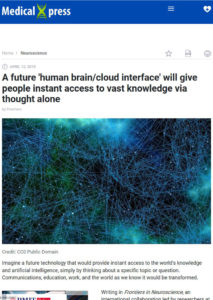 A future ‘human brain/cloud interface’ will give people instant access to vast knowledge via thought alone
A future ‘human brain/cloud interface’ will give people instant access to vast knowledge via thought alone
https://medicalxpress.com/news/2019-04-future-human-braincloud-interface-people.html
Unexplained Mysteries.com
https://www.unexplained-mysteries.com/forum/topic/326941-the-human-braincloud-interface/
New ‘human brain/cloud interface’ could help you gain knowledge via thought
Wonderfest Science
https://www.facebook.com/permalink.php?id=155872821274&story_fbid=10156356708921275
Technology Think Tank
https://www.facebook.com/permalink.php?id=244445989031992&story_fbid=1363078343835412
‘Human brains may directly connect to cloud networks in future’
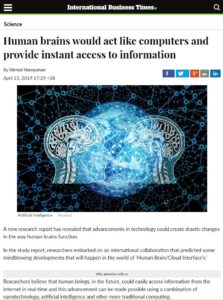 Human brains would act like computers and provide instant access to information https://www.ibtimes.sg/human-brains-would-act-like-computers-provide-instant-access-information-30274
Human brains would act like computers and provide instant access to information https://www.ibtimes.sg/human-brains-would-act-like-computers-provide-instant-access-information-30274
Scientists propose putting nanobots in our bodies to create ‘global superbrain’
https://www.siliconrepublic.com/machines/brain-cloud-interface-nanobots-global-superbrain
Scientists say our brains will connect to computers in decades to form the ‘internet of thoughts’
InfoHighTech
‘Human brains’ may get instant access to world’s knowledge by thinking about topic
Heads in the cloud: Scientists predict internet of thoughts ‘within decades’
https://www.nanowerk.com/nanotechnology-news2/newsid=52587.php
https://www.technocracy.news/the-feed-real-human-brain-cloud-interface-coming-within-decades/
Heads in the cloud: Scientists predict internet of thoughts ‘within decades’
https://neurosciencenews.com/internet-thoughts-brain-cloud-interface-11074/
LifeBoat Foundation
Heads in the cloud: Scientists predict internet of thoughts ‘within decades’
We Are Closer Than Ever to Merging Human Brains With The Cloud
 Human brains could be connected to the internet in ‘next few decades,’ scientists predict
Human brains could be connected to the internet in ‘next few decades,’ scientists predict
https://www.foxnews.com/science/human-brains-connected-internet-scientists-predict
Human brain could connect to internet ‘within decades’, theory suggests
Future ‘Human Brain/Cloud Interface’ Will Give People Instant Access to Vast Knowledge Via Thought Alone
Humans to be connected to THE CLOUD within ‘decades’ giving instant access to EVERYTHING
Before the end of the century, will we connect our brains with cloud computing?
Researchers predict Matrix-style ‘internet of thoughts’ within next few decades
https://www.rt.com/news/456686-matrix-internet-of-thoughts-prediction/
From the brain directly into the cloud
https://www.labnews.co.uk/news/internet-of-thoughts-16-04-2019/
Scientists to connect human brains directly to internet ‘within decades’
Human brains could merge with technology sooner than we think
https://nypost.com/2019/04/16/human-brains-could-merge-with-technology-sooner-than-we-think/
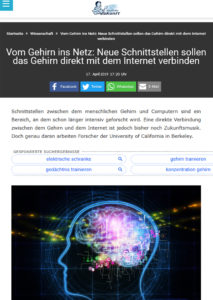 From the brain to the net: new interfaces are supposed to connect the brain directly to the internet
From the brain to the net: new interfaces are supposed to connect the brain directly to the internet
Straight from Science fictions! ‘Human brains may directly connect to cloud networks in future’
Nanotech breakthrough may lead to an ‘Internet of Brains’
Scientists predict the human brain could be connected to the internet in ‘next few decades’
We Are Closer Than Ever to Merging Human Brains With The Cloud
Heads in the cloud: Scientists predict internet of thoughts ‘within decades’
https://www.sciencedaily.com/releases/2019/04/190412094736.htm
Brain & Cloud Interface Combine Human Mind with Artificial Intelligence
https://bilimfili.com/beyin-bulut-arayuzu-insan-zihni-ile-yapay-zekayi-birlestirebilir/
Human brains may directly connect to cloud networks in future
 A new interface will give people instant access to the Internet only through the power of thought
A new interface will give people instant access to the Internet only through the power of thought
https://www.descopera.ro/stiinta/18084796-interfata-creier-internet-aproape-realitate
The ‘internet of thoughts’ might only be decades away
https://bigthink.com/technology-innovation/singularity-futurism
A new interface connects the brain with the cloud in this century.
Human Brain/Cloud Interface
Human Brain/Cloud Interface
 Brain & Cloud Interface Combine Human Mind with Artificial Intelligence
Brain & Cloud Interface Combine Human Mind with Artificial Intelligence
https://bilimfili.com/beyin-bulut-arayuzu-insan-zihni-ile-yapay-zekayi-birlestirebilir/
Experts Predict Human Brain Can Access Online Through Thought Alone, predict expert
Super-human brains connected to the internet coming in ‘next few decades’ as scientists reveal bold plan to put nanorobots in our head
https://www.thesun.co.uk/tech/8866149/scientists-to-put-nanorobots-in-brains/
Prediction of an internet with thoughts by scientists within decades
Internet Of Thoughts: You Might Gain Knowledge By Simply Thinking About Topics In The Future
Human brains may directly connect to cloud networks in future
More…
Human brain/cloud interface
https://evan-gcrm.livejournal.com/1430090.html
The human brain could be connected to the internet in the near future
Scientists Predict ‘Internet of Thoughts’ Within Decades
https://cacm.acm.org/careers/236196-scientists-predict-internet-of-thoughts-within-decades/fulltext
Your Brain Will Be in the Cloud
https://medium.com/@JimWexler/your-brain-will-be-in-the-cloud-48b54326979f
Super-human brains connected to the internet coming in ‘next few decades’ as scientists reveal bold plan to put nanorobots in our head
Enter The Matrix – Internet Of Thoughts Is Coming – Disturbing Or Exciting Technology?
Humans will be plugged into a ‘Matrix-style global superbrain’ this century, scientists predict
RESISTANCE IS FUTILE! YOU WILL BE ASSIMILATED! Future ‘Human Brain/Cloud Interface’ Under Design That Will Give People Instant Access To Vast Knowledge Via Thought Alone
‘Human brains may directly connect to cloud networks in future’
Humans May Have Search Engine Tech in Our Brains ‘Within Decades’
https://pjmedia.com/lifestyle/humans-may-have-search-engine-tech-in-our-brains-within-decades/
Walking Dead creator will explore dystopian future where social media is linked to your BRAIN using tech that ‘Elon Musk and Facebook are already trying to develop’
Our brain in the data cloud? We’re getting closer
With my head in the cloud. Scientists predict the connection of the brain with cloud computing until the end of the century
Human Brains May Directly Connect To Cloud Networks In Future
Scientist Predict the Human Brain Could be Connected to the Internet in ‘Next Few Decades’
In a couple of decades, the brain will be connected to the Internet.
https://habr.com/ru/company/cloud4y/blog/448728/
© Alias Group Creative/ Amanda Scott – No usage without written permission
News This Week
The Secret “Radar” Bacteria Use To Outsmart Their Enemies
A chemical radar allows bacteria to sense and eliminate predators. Investigating how microorganisms communicate deepens our understanding of the complex ecological interactions that shape our environment is an area of key focus for the [...]
Psychologists explore ethical issues associated with human-AI relationships
It's becoming increasingly commonplace for people to develop intimate, long-term relationships with artificial intelligence (AI) technologies. At their extreme, people have "married" their AI companions in non-legally binding ceremonies, and at least two people [...]
When You Lose Weight, Where Does It Actually Go?
Most health professionals lack a clear understanding of how body fat is lost, often subscribing to misconceptions like fat converting to energy or muscle. The truth is, fat is actually broken down into carbon [...]
How Everyday Plastics Quietly Turn Into DNA-Damaging Nanoparticles
The same unique structure that makes plastic so versatile also makes it susceptible to breaking down into harmful micro- and nanoscale particles. The world is saturated with trillions of microscopic and nanoscopic plastic particles, some smaller [...]
AI Outperforms Physicians in Real-World Urgent Care Decisions, Study Finds
The study, conducted at the virtual urgent care clinic Cedars-Sinai Connect in LA, compared recommendations given in about 500 visits of adult patients with relatively common symptoms – respiratory, urinary, eye, vaginal and dental. [...]
Challenging the Big Bang: A Multi-Singularity Origin for the Universe
In a study published in the journal Classical and Quantum Gravity, Dr. Richard Lieu, a physics professor at The University of Alabama in Huntsville (UAH), which is a part of The University of Alabama System, suggests that [...]
New drug restores vision by regenerating retinal nerves
Vision is one of the most crucial human senses, yet over 300 million people worldwide are at risk of vision loss due to various retinal diseases. While recent advancements in retinal disease treatments have [...]
Shingles vaccine cuts dementia risk by 20%, new study shows
A shingles shot may do more than prevent rash — it could help shield the aging brain from dementia, according to a landmark study using real-world data from the UK. A routine vaccine could [...]

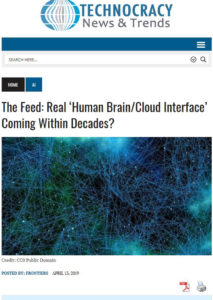
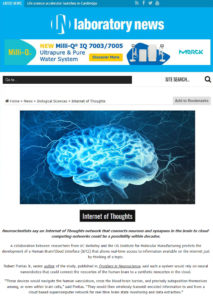













Leave A Comment